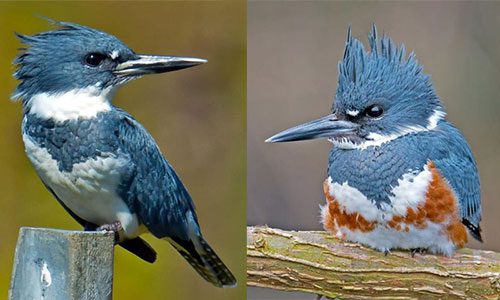Why do female Belted Kingfishers have an extra rust-colored “belt” that the males don’t have?
When a species is sexually dimorphic—meaning the males and females look different—the overwhelming pattern is for males to be more colorful than females. But in a few species this setup is reversed. Often, this comes along with a reversal in sex roles—one example is in shorebirds called phalaropes, where the females are more colorful and the males tend the nests. However, in the Belted Kingfisher the female has an “extra” belt but there’s no such reversal in roles. What’s going on?
There are a couple of possibilities, although the final answer has yet to be found. One suggestion comes from the idea that most features of a species arise because they confer some kind of advantage (scientists call this an “adaptationist” view.) A study in the 1970s suggested that the plumage difference helps male kingfishers recognize females, and that it arises from a quirk in kingfisher migration.
Belted Kingfishers are highly territorial, and males sometimes remain on their territories year-round, presumably so they don’t risk giving up prime nesting real estate. The females, on the other hand, migrate south for the winter. When the females return, the males are already in the midst of defending their territories. So glimpsing a flash of a bright, rusty belt could be a signal that he should welcome the visitor, rather than chasing her off.
While this is a compelling idea, some scientists argue that not all explanations have to be adaptationist in nature. Some features come about as a result of the development of other features, rather than for any specific reason of their own. For example, female kingfishers tend to be more aggressive and territorial than males during the breeding season. This may mean that female kingfishers have higher-than-normal testosterone levels—and high testosterone levels may also affect the way pigments are incorporated into a bird’s plumage. The necessary studies to distinguish between these two possibilities—or to test still other hypotheses—have yet to be done. It’s a good example of how scientific questions are all around us, waiting for curious people to investigate.
For more about Belted Kingfishers, visit our All About Birds species guide.


All About Birds is a free resource
Available for everyone,
funded by donors like you



